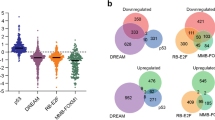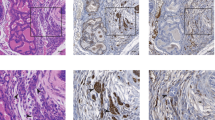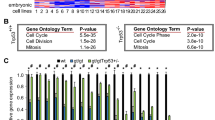Abstract
To identify new immortalizing genes with potential roles in tumorigenesis, we performed a genetic screen aimed to bypass the rapid and tight senescence arrest of primary fibroblasts deficient for the oncogene Bmi1. We identified the T-box member TBX2 as a potent immortalizing gene that acts by downregulating Cdkn2a (p19ARF). TBX2 represses the Cdkn2a (p19ARF) promoter and attenuates E2F1, Myc or HRAS-mediated induction of Cdkn2a (p19ARF). We found TBX2 to be amplified in a subset of primary human breast cancers, indicating that it might contribute to breast cancer development.
This is a preview of subscription content, access via your institution
Access options
Subscribe to this journal
Receive 12 print issues and online access
We are sorry, but there is no personal subscription option available for your country.
Buy this article
- Purchase on SpringerLink
- Instant access to full article PDF
Prices may be subject to local taxes which are calculated during checkout








Similar content being viewed by others
References
Wynford-Thomas, D. Cellular senescence and cancer. J. Pathol. 187, 100–111 (1999).
Levine, A.J. p53, the cellular gatekeeper for growth and division. Cell 88, 323–333 (1997).
Serrano, M., Hannon, G.J. & Beach, D. A new regulatory motif in cell-cycle control causing specific inhibition of cyclin D/CDK4. Nature 366, 704–707 (1993).
Ruas, M. & Peters, G. The p16INK4a/CDKN2A tumor suppressor and its relatives. Biochim. Biophys. Acta 1378, F115–F177 (1998).
Sherr, C.J. Tumor surveillance via the ARF-p53 pathway. Genes Dev. 12, 2984–2991 (1998).
Sharpless, N.E. & DePinho, R.A. The INK4A/ARF locus and its two gene products. Curr. Opin. Genet. Dev. 9, 22–30 (1999).
Quelle, D.E., Zindy, F., Ashmun, R.A. & Sherr, C.J. Alternative reading frames of the INK4a tumor suppressor gene encode two unrelated proteins capable of inducing cell cycle arrest. Cell 83, 993–1000 (1995).
Kamijo, T. et al. Functional and physical interactions of the ARF tumor suppressor with p53 and Mdm2. Proc. Natl Acad. Sci. USA 95, 8292–8297 (1998).
Pomerantz, J. et al. The Ink4a tumor suppressor gene product p19ARF, interacts with MDM2 and neutralizes MDM2' s inhibition of p53. Cell 92, 713–723 (1998).
Stott, F.J. et al. The alternative product from the human CDKN2A locus, p14ARF, participates in a regulatory feedback loop with p53 and MDM2. EMBO J. 17, 5001–5014 (1998).
Zhang, Y., Xiong, Y. & Yarbrough, W.G. ARF promotes MDM2 degradation and stabilizes p53: ARF-INK4a locus deletion impairs both the Rb and p53 tumor suppression pathways. Cell 92, 725–734 (1998).
Weber, J.D., Taylor, L.J., Roussel, M.F., Sherr, C.J. & Bar-Sagi, D. Nucleolar ARF sequesters Mdm2 and activates p53. Nature Cell Biol. 1, 20–26 (1999).
Zhang, Y. & Xiong, Y. Mutations in human ARF exon 2 disrupt its nucleolar localization and impair its ability to block nuclear export of MDM2 and p53. Mol. Cell 3, 579–591 (1999).
Tao, W. & Levine, A.J. P19ARF stabilizes p53 by blocking nucleo-plasmic shuttling of Mdm2. Proc. Natl Acad. Sci. USA 96, 6937–6941 (1999).
Sherr, C.J. & Weber, J.D. The ARF/p53 pathway. Curr. Opin. Genet. Dev. 10, 94–99 (2000).
Eischen C.M., Weber, J.D., Roussel, M.F., Sherr, C.J. & Cleveland, J.L. Disruption of the ARF-Mdm2-p53 tumor suppressor pathway in Myc-induced lymphomagenesis. Genes Dev. 13, 2658–2669 (1999).
Schmitt, C.A., McCurrach, M.E., de Stanchina, E., Wallace-Brodeur, R.R. & Lowe, S.W. INK4a/ARF mutations accelerate lymphomagenesis and promote chemoresistance by disabling p53. Genes Dev. 13, 2670–2677 (1999).
Jacobs, J.J.L. et al. Bmi-1 collaborates with c-Myc in tumorigenesis by inhibiting c-Myc-induced apoptosis via INK4a/ARF. Genes Dev. 13, 2678–2690 (1999).
Jacobs, J.J.L., Kieboom, K., Marino, S., DePinho, R.A. & van Lohuizen, M. The oncogene and Polycomb-group gene bmi-1 regulates cell proliferation and senescence through the ink4a locus. Nature 397, 164–168 (1999).
Haupt, Y., Bath, M.L., Harris, A.W. & Adams, J.M. Bmi1 transgene induces lymphomas and collaborates with myc in tumorigenesis. Oncogene 8, 3161–3164 (1993).
Alkema, M.J., Jacobs, H., van Lohuizen, M. & Berns, A. Perturbation of B and T cell development and predisposition to lymphomagenesis in Eμ-Bmi1 transgenic mice require the Bmi1 RING finger. Oncogene 15, 899–910 (1997).
Campbell, C., Goodrich, K., Casey, G. & Beatty, B. Cloning and mapping of a human gene (TBX2) sharing a highly conserved protein motif with the Drosophila omb gene. Genomics 28, 255–260 (1995).
Law, D.J., Gebuhr, T., Garvey, N., Agulnik, S.I. & Silver, L.M. Identification, characterization, and localization to chromosome 17q21–22 of the human TBX2 homolog, member of a conserved developmental gene family. Mamm. Genome 6, 793–797 (1995).
Papaioannou, V.E. & Silver, L.M. The T-box gene family. Bioessays 20, 9–19 (1998).
Quelle, D.E. et al. Cloning and characterization of murine p16INK4a and p15INK4b genes. Oncogene 11, 635–645 (1995).
Kamijo, T.F. et al. Tumor suppression at the mouse INK4a locus mediated by the alternative reading frame product p19ARF. Cell 91, 649–659 (1997).
Serrano, M. et al. Role of the INK4a locus in tumor suppression and cell mortality. Cell 85, 27–37 (1996).
Zindy, F. et al. Myc signaling via the ARF tumor suppressor regulates p53-dependent apoptosis and immortalization. Genes Dev. 12, 2424–2433 (1998).
Inoue, K., Roussel, M.F. & Sherr, C.J. Induction of ARF tumor suppressor gene expression and cell cycle arrest by transcription factor DMP1. Proc. Natl Acad. Sci. USA 96, 3993–3998 (1999).
Bates, S. et al. p14ARF links the tumour suppressors RB and p53. Nature 395,124–125 (1998).
Robertson, K.D. & Jones, P.A. The human ARF cell cycle regulatory gene promoter is a CpG island which can be silenced by DNA methylation and down-regulated by wild-type p53. Mol. Cell. Biol. 18, 6457–6473 (1998).
Carreira, S., Dexter, T.J., Yavuzer, U., Easty, D.J. & Goding, C.R. Brachyury-related transcription factor Tbx2 and repression of the melanocyte-specific TRP-1 promoter. Mol. Cell. Biol. 18, 5099–5108 (1998).
He, M.I., Wen, L., Campbell, C.E., Wu, J.Y. & Rao, Y. Transcription repression by Xenopus ET and its human ortholog TBX3, a gene involved in ulnar-mammary syndrome. Proc. Natl Acad. Sci. USA 96, 10212–10217 (1999).
Maestro, R. et al. Twist is a potential oncogene that inhibits apoptosis. Genes Dev. 13, 2207–2217 (1999).
Courjal, F. & Theillet, C. Comparative genomic hybridization analysis of breast tumors with predetermined profiles of DNA amplification. Cancer Res. 57, 4368–4377 (1997).
Barlund, M. et al. Increased copy number at 17q22–24 by CGH in breast cancer is due to high-level amplification of two separate regions. Genes Chromosomes Cancer 20, 372–376 (1997).
Weber, R.G. et al. Analysis of genomic alterations in benign, atypical, and anaplastic meningiomas: toward a genetic model of meningioma progression. Proc. Natl Acad. Sci. USA 94, 14719–14724 (1997).
Pedeutour, F. et al. Ring 22 chromosomes in dermatofibrosarcoma protuberans are low-level amplifiers of chromosome 17 and 22 sequences. Cancer Res. 55, 2400–2403 (1995).
Couch, F.J. et al. Localization of PS6K to chromosomal region 17q23 and determination of its amplification in breast cancer. Cancer Res. 59, 1408–1411 (1999).
Cuny, M. et al. Relating genotype and phenotype in breast cancer: an analysis of the prognostic significance of amplification at eight different genes or loci and of p53 mutations. Cancer Res. 60, 1077–1083 (2000).
Tanaka, N. et al. Cellular commitment to oncogene-induced transformation or apoptosis is dependent on the transcription factor IRF-1. Cell 77, 829–839 (1994).
Gibson-Brown, J.J., Agulnik, S.I., Silver, L.M., Niswander, L. & Papaioannou, V.E. Involvement of T-box genes Tbx2-Tbx5 in vertebrate limb specification and development. Development 125, 2499–2509 (1998).
Li, L.-H., Nerlov, C., Prendergast, G., MacGregor, D. & Ziff, E.B. c-Myc represses transcription in vivo by a novel mechanism dependent on the initiator element and Myc box II. EMBO J. 13, 4070–4079 (1994).
Wicking, C., Smyth, I. & Bale, A. The hedgehog signaling pathway in tumorigenesis and development. Oncogene 18, 7844–7851 (1999).
Miller, J.R., Hocking, A.M., Brown, J.D. & Moon, R.T. Mechanism and function of signal transduction by the Wnt/β-catenin and Wnt/Ca2+ pathways. Oncogene 18, 7860–7872 (1999).
Nusse, R. & Varmus, H.E. Many tumors induced by the mouse mammary tumor virus contain a provirus integrated in the same region of the host genome. Cell 31, 99–109 (1982).
Roose, J. et al. Synergy between tumor suppressor APC and the β-catenin-Tcf4 _target Tcf1. Science 285, 1923–1926 (1999).
He, T.-C. et al. Identification of c-MYC as a _target of the APC pathway. Science 281, 1509–1512 (1998).
van Lohuizen, M. et al. Identification of cooperating oncogenes in Eμ-myc transgenic mice by provirus tagging. Cell 65, 735–752 (1991).
Clahsen, P.C. et al. p53 protein accumulation and response to adjuvant chemotherapy in premenopausal women with node-negative early breast cancer. J. Clin. Oncol. 16, 470–479 (1998).
Acknowledgements
We thank K. Berns for providing retroviral library DNA; C.J. Sherr for Cdkn2a (ARF)−/− mice; R.A. DePinho for Cdkn2a (INK4a/ARF)−/− mice; L.A. Donehower for Trp53−/− mice; S. Jones for Mdm2−/−;Trp53−/− MEFs; P. Jones for CDKN2A (ARF) promoter-CAT reporter plasmids; M.Oren for cyclin G-Luc plasmid; G. Zambetti for 2A10 (αMdm2) serum; H. Masselink and M. Hijmans for pCMV-E2F1 plasmid; K. Kieboom, C. Bosch, D. Atsma and J. Poodt for technical assistance; A.H. Lund for the 1.7-kb mouse Cdkn2a (ARF) promoter-Luciferase reporter; and R. Agami and J.-W. Voncken for comments on the manuscript. J.J.L.J, P.K. and E.R.M were supported by grants from the Dutch Cancer Society (K.W.F). G.Q.D was supported by grants from the Edward Mallinckrodt, Jr. Foundation and NCI CA76418-01.
Author information
Authors and Affiliations
Corresponding author
Rights and permissions
About this article
Cite this article
Jacobs, J., Keblusek, P., Robanus-Maandag, E. et al. Senescence bypass screen identifies TBX2, which represses Cdkn2a (p19ARF) and is amplified in a subset of human breast cancers. Nat Genet 26, 291–299 (2000). https://doi.org/10.1038/81583
Received:
Accepted:
Issue Date:
DOI: https://doi.org/10.1038/81583
This article is cited by
-
Cellular senescence in neuroblastoma
British Journal of Cancer (2022)
-
Combined genomic and proteomic approaches reveal DNA binding sites and interaction partners of TBX2 in the developing lung
Respiratory Research (2021)
-
TBX3 represses TBX2 under the control of the PRC2 complex in skeletal muscle and rhabdomyosarcoma
Oncogenesis (2019)
-
TBX2 interacts with heterochromatin protein 1 to recruit a novel repression complex to EGR1-_targeted promoters to drive the proliferation of breast cancer cells
Oncogene (2019)
-
Transcriptional repression of the ectodomain sheddase ADAM10 by TBX2 and potential implication for Alzheimer’s disease
Cellular and Molecular Life Sciences (2019)



